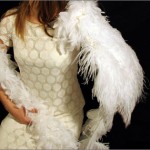Reimagining the prosthetic arm, an article by Cliff Kuang in Fast Company (here) highlights a student design project at New York’s School of Visual Arts. Students were asked to improve prosthetic arms and were given four categories: decorative, playful, utilitarian, and awareness. This one by Tonya Douraghey and Carli Pierce caught my fancy, after all, who hasn’t thought of growing wings? (Rrom the Fast Company website),

Feathered cuff and wing arm
I suggest reading Kuang’s article before heading off to the project website to see more student projects.
At the end of yesterday’s posting about MICA and multidimensional data visualization in spaces with up to 12 dimensions (here) in virtual worlds such as Second Life, I made a comment about multimodal discourse which is something I think will become increasingly important. I’m not sure I can imagine 12 dimensions but I don’t expect that our usual means of visualizing or understanding data are going to be sufficient for the task. Consequently, I’ve been noticing more projects which engage some of our other senses, notably touch. For example, the SIGGRAPH 2009 conference in New Orleans featured a hologram that you can touch. This is another article by Cliff Kuang in Fast Company, Holograms that you can touch and feel. For anyone unfamiliar with SIGGRAPH, the show has introduced a number of important innovations, notably, clickable icons. It’s hard to believe but there was a time when everything was done by keyboard.
My August newsletter from NISE Net (Nanoscale Informal Science Education Network) brings news of a conference in Seattle, WA at the Pacific Science Centre, Sept. 8 – 11, 2009. It will feature (from the NISE Net blog),
Members of the NISE Net Program group and faculty and students at the Center for Nanotechnology in Society at Arizona State University are teaming up to demonstrate and discuss potential collaborations between the social science community and the informal science education community at a conference of the Society for the Study of Nanoscience and Emerging Technologies in Seattle in early September.
There’s more at the NISE Net blog here including a link to the conference site. (I gather the Society for the Study of Nanoscience and Emerging Nanotechnologies is in its very early stages of organizing so this is a fairly informal call for registrants.)
The NISE Net nano haiku this month is,
Nanoparticles
Surface plasmon resonance
Silver looks yellowby Dr. Katie D. Cadwell of the University of Wisconsin-Madison MRSEC.